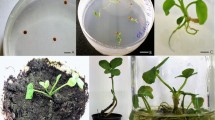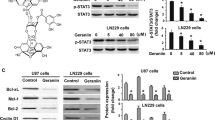Abstract
Hippophae rhamnoides L., also known as sea buckthorn (SBT), possesses a wide range of biological and pharmacological activities. However, the underlying mechanism is largely unknown. The present study examined whether SBT leaf extract could inhibit proliferation and promote apoptosis of rat glioma C6 cells. The results revealed that the treatment with SBT leaf extract inhibited proliferation of rat C6 glioma cells in a dose-dependent manner. SBT-induced reduction of C6 glioma cell proliferation and viability was accompanied by a decrease in production of reactive oxygen species (ROS), which are critical for the proliferation of tumor cells. SBT treatment not only significantly upregulated the expression of the pro-apoptotic protein Bcl-2-associated X (Bax) but also promoted its localization in the nucleus. Although increased expression and nuclear translocation of Bax were observed in SBT-treated C6 glioma cells, the induced nuclear morphological change was distinct from that of typical apoptotic cells in that most of SBT-treated cells were characterized by convoluted nuclei with cavitations and clumps of chromatin. All of these results suggest that SBT leaf extract could inhibit the rapid proliferation of rat C6 glioma cells, possibly by inducing the early events of apoptosis. Thus, SBT may serve as a potential therapeutic candidate for the treatment of glioma.



Similar content being viewed by others
References
Kuijlen, J. M., Bremer, E., Mooij, J. J., den Dunnen, W. F., & Helfrich, W. (2010). Review: on TRAIL for malignant glioma therapy? Neuropathology and Applied Neurobiology, 36, 168–182.
Karpel-Massler, G., Schmidt, U., Unterberg, A., & Halatsch, M. E. (2009). Therapeutic inhibition of the epidermal growth factor receptor in high-grade gliomas: where do we stand? Molecular cancer research: MCR, 7, 1000–1012.
Narayana, A., Kelly, P., Golfinos, J., Parker, E., Johnson, G., Knopp, E., et al. (2009). Antiangiogenic therapy using bevacizumab in recurrent high-grade glioma: impact on local control and patient survival. Journal of Neurosurgery, 110, 173–180.
Iacob, G., & Dinca, E. B. (2009). Current data and strategy in glioblastoma multiforme. Journal of Medicine and Life, 2, 386–393.
Kamata, H., & Hirata, H. (1999). Redox regulation of cellular signalling. Cellular Signalling, 11, 1–14.
Halliwell, B. (2011). Free radicals and antioxidants—quo vadis? Trends in Pharmacological Sciences, 32, 125–130.
Storz, P. (2005). Reactive oxygen species in tumor progression. Frontiers in bioscience: a journal and virtual library, 10, 1881–1896.
Trachootham, D., Alexandre, J., & Huang, P. (2009). Targeting cancer cells by ROS-mediated mechanisms: a radical therapeutic approach? Nature reviews. Drug discovery, 8, 579–591.
Prados, M. D., & Levin, V. (2000). Biology and treatment of malignant glioma. Seminars in Oncology, 27, 1–10.
Liu, B., Tan, X. Y., Liang, J., Wu, S. X., Liu, J., Zhang, Q. Y., et al. (2015). A reduction in reactive oxygen species contributes to dihydromyricetin-induced apoptosis in human hepatocellular carcinoma cells. Sci Rep-Uk, 4, 7041.
Dutot, M., Fagon, R., Hemon, M., & Rat, P. (2012). Antioxidant, anti-inflammatory, and anti-senescence activities of a phlorotannin-rich natural extract from brown seaweed Ascophyllum nodosum. Applied Biochemistry and Biotechnology, 167, 2234–2240.
Horie, Y., Nemoto, H., Itoh, M., Kosaka, H., & Morita, K. (2016). Fermented brown rice extract causes apoptotic death of human acute lymphoblastic leukemia cells via death receptor pathway. Applied Biochemistry and Biotechnology, 178, 1599–1611.
Jha, M., Aggarwal, R., Jha, A. K., & Shrivastava, A. (2015). Natural compounds: DNA methyltransferase inhibitors in oral squamous cell carcinoma. Applied Biochemistry and Biotechnology, 177, 577–594.
Suryakumar, G., & Gupta, A. (2011). Medicinal and therapeutic potential of sea buckthorn (Hippophae rhamnoides L.). Journal of Ethnopharmacology, 138, 268–278.
Zheng, X., Long, W., Liu, G., Zhang, X., & Yang, X. (2012). Effect of seabuckthorn (Hippophae rhamnoides ssp. sinensis) leaf extract on the swimming endurance and exhaustive exercise-induced oxidative stress of rats. Journal of the Science of Food and Agriculture, 92, 736–742.
Pintea, A., Marpeau, A., Faye, M., Socaciu, C., & Gleizes, M. (2001). Polar lipid and fatty acid distribution in carotenolipoprotein complexes extracted from sea buckthorn fruits. Phytochemical analysis: PCA, 12, 293–298.
Yang, B., & Kallio, H. P. (2001). Fatty acid composition of lipids in sea buckthorn (Hippophae rhamnoides L.) berries of different origins. Journal of Agricultural and Food Chemistry, 49, 1939–1947.
Guo, R., Guo, X., Li, T., Fu, X., & Liu, R. H. (2017). Comparative assessment of phytochemical profiles, antioxidant and antiproliferative activities of sea buckthorn (Hippophae rhamnoides L.) berries. Food Chemistry, 221, 997–1003.
Kuduban, O., Mazlumoglu, M. R., Kuduban, S. D., Erhan, E., Cetin, N., Kukula, O., et al. (2016). The effect of Hippophae rhamnoides extract on oral mucositis induced in rats with methotrexate. Journal of applied oral science: revista FOB, 24, 423–430.
Ganju, L., Padwad, Y., Singh, R., Karan, D., Chanda, S., Chopra, M. K., et al. (2005). Anti-inflammatory activity of seabuckthorn (Hippophae rhamnoides) leaves. International Immunopharmacology, 5, 1675–1684.
Geetha, S., Sai Ram, M., Singh, V., Ilavazhagan, G., & Sawhney, R. C. (2002). Anti-oxidant and immunomodulatory properties of seabuckthorn (Hippophae rhamnoides)—an in vitro study. Journal of Ethnopharmacology, 79, 373–378.
Hibasami, H., Mitani, A., Katsuzaki, H., Imai, K., Yoshioka, K., & Komiya, T. (2005). Isolation of five types of flavonol from seabuckthorn (Hippophae rhamnoides) and induction of apoptosis by some of the flavonols in human promyelotic leukemia HL-60 cells. International Journal of Molecular Medicine, 15, 805–809.
Yasukawa, K., Kitanaka, S., Kawata, K., & Goto, K. (2009). Anti-tumor promoters phenolics and triterpenoid from Hippophae rhamnoides. Fitoterapia, 80, 164–167.
Upadhyay, N. K., Kumar, M. S., & Gupta, A. (2010). Antioxidant, cytoprotective and antibacterial effects of sea buckthorn (Hippophae rhamnoides L.) leaves. Food and Chemical Toxicology: An International Journal Published for the British Industrial Biological Research Association, 48, 3443–3448.
Grobben, B., De Deyn, P. P., & Slegers, H. (2002). Rat C6 glioma as experimental model system for the study of glioblastoma growth and invasion. Cell and Tissue Research, 310, 257–270.
Kim, I. S., Yang, M. R., Lee, O. H., & Kang, S. N. (2011). Antioxidant activities of hot water extracts from various spices. International Journal of Molecular Sciences, 12, 4120–4131.
Thaipong, K., Boonprakob, U., Crosby, K., Cisneros-Zevallos, L., & Byrne, D. H. (2006). Comparison of ABTS, DPPH, FRAP, and ORAC assays for estimating antioxidant activity from guava fruit extracts. Journal of Food Composition and Analysis, 19, 669–675.
Price, M. L., Vanscoyoc, S., & Butler, L. G. (1978). Critical evaluation of vanillin reaction as an assay for tannin in sorghum grain. Journal of Agricultural and Food Chemistry, 26, 1214–1218.
Hong, M., Song, K. D., Lee, H. K., Yi, S., Lee, Y. S., Heo, T. H., et al. (2016). Fibrates inhibit the apoptosis of batten disease lymphoblast cells via autophagy recovery and regulation of mitochondrial membrane potential. In Vitro Cellular & Developmental Biology. Animal, 52, 349–355.
Jun, H. S., Weinstein, D. A., Lee, Y. M., Mansfield, B. C., & Chou, J. Y. (2014). Molecular mechanisms of neutrophil dysfunction in glycogen storage disease type Ib. Blood, 123, 2843–2853.
Kumar, M. S., Dutta, R., Prasad, D., & Misra, K. (2011). Subcritical water extraction of antioxidant compounds from seabuckthorn (Hippophae rhamnoides) leaves for the comparative evaluation of antioxidant activity. Food Chemistry, 127, 1309–1316.
Grey, C., Widen, C., Adlercreutz, P., Rumpunen, K., & Duan, R. D. (2010). Antiproliferative effects of sea buckthorn (Hippophae rhamnoides L.) extracts on human colon and liver cancer cell lines. Food Chemistry, 120, 1004–1010.
Upadhyay, N. K., Kumar, R., Mandotra, S. K., Meena, R. N., Siddiqui, M. S., Sawhney, R. C., et al. (2009). Safety and healing efficacy of sea buckthorn (Hippophae rhamnoides L.) seed oil on burn wounds in rats. Food and Chemical Toxicology: An International Journal Published for the British Industrial Biological Research Association, 47, 1146–1153.
Chahar, M. K., Sharma, N., Dobhal, M. P., & Joshi, Y. C. (2011). Flavonoids: a versatile source of anticancer drugs. Pharmacognosy Reviews, 5, 1–12.
Olsson, M. E., Gustavsson, K. E., Andersson, S., Nilsson, A., & Duan, R. D. (2004). Inhibition of cancer cell proliferation in vitro by fruit and berry extracts and correlations with antioxidant levels. Journal of Agricultural and Food Chemistry, 52, 7264–7271.
Teng, B. S., Lu, Y. H., Wang, Z. T., Tao, X. Y., & Wei, D. Z. (2006). In vitro anti-tumor activity of isorhamnetin isolated from Hippophae rhamnoides L. against BEL-7402 cells. Pharmacological Research, 54, 186–194.
Padmavathi, B., Upreti, M., Singh, V., Rao, A. R., Singh, R. P., & Rath, P. C. (2005). Chemoprevention by Hippophae rhamnoides: effects on tumorigenesis, phase II and antioxidant enzymes, and IRF-1 transcription factor. Nutrition and Cancer, 51, 59–67.
Li, G. X., Chen, Y. K., Hou, Z., Xiao, H., Jin, H., Lu, G., et al. (2010). Pro-oxidative activities and dose-response relationship of (−)-epigallocatechin-3-gallate in the inhibition of lung cancer cell growth: a comparative study in vivo and in vitro. Carcinogenesis, 31, 902–910.
Sena, L. A., & Chandel, N. S. (2012). Physiological roles of mitochondrial reactive oxygen species. Molecular Cell, 48, 158–167.
Szatrowski, T. P., & Nathan, C. F. (1991). Production of large amounts of hydrogen peroxide by human tumor cells. Cancer Research, 51, 794–798.
Shibuya, N., & Kimura, H. (2013). Production of hydrogen sulfide from d-cysteine and its therapeutic potential. Frontiers in Endocrinology, 4, 87.
Shibuya, N., Koike, S., Tanaka, M., Ishigami-Yuasa, M., Kimura, Y., Ogasawara, Y., et al. (2013). A novel pathway for the production of hydrogen sulfide from D-cysteine in mammalian cells. Nature Communications, 4, 1366.
Thompson, C. B. (1995). Apoptosis in the pathogenesis and treatment of disease. Science, 267, 1456–1462.
Wyllie, A. H. (1995). The genetic regulation of apoptosis. Current Opinion in Genetics & Development, 5, 97–104.
Oltvai, Z. N., Milliman, C. L., & Korsmeyer, S. J. (1993). Bcl-2 heterodimerizes in vivo with a conserved homolog, Bax, that accelerates programmed cell death. Cell, 74, 609–619.
Gajkowska, B., Motyl, T., Olszewska-Badarczuk, H., & Godlewski, M. M. (2001). Expression of BAX in cell nucleus after experimentally induced apoptosis revealed by immunogold and embedment-free electron microscopy. Cell Biology International, 25, 725–733.
Joy, A., Panicker, S., & Shapiro, J. R. (2000). Altered nuclear localization of bax protein in BCNU-resistant glioma cells. Journal of Neuro-Oncology, 49, 117–129.
Acknowledgments
This work was carried out with the support of “Cooperative Research Program for Agriculture Science & Technology Development (Project No. PJ01104601 and Project No. PJ01183401)” Rural Development Administration, Republic of Korea.
Author information
Authors and Affiliations
Corresponding authors
Ethics declarations
Conflict of Interest
The authors declare that they have no conflict of interest.
Additional information
Sung-Jo Kim and Eunmi Hwang authors have contributed equally to the work.
Rights and permissions
About this article
Cite this article
Kim, SJ., Hwang, E., Yi, S.S. et al. Sea Buckthorn Leaf Extract Inhibits Glioma Cell Growth by Reducing Reactive Oxygen Species and Promoting Apoptosis. Appl Biochem Biotechnol 182, 1663–1674 (2017). https://doi.org/10.1007/s12010-017-2425-4
Received:
Accepted:
Published:
Issue Date:
DOI: https://doi.org/10.1007/s12010-017-2425-4




